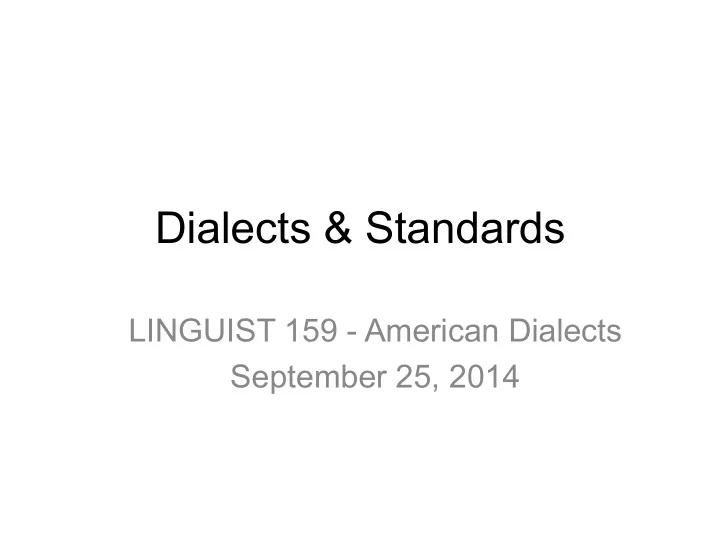

Dialects & Standards LINGUIST 159 - American Dialects September 25, 2014
Source: The Atlas of North American English (Labov, Ash, & Boberg 2005)
What ¡is ¡a ¡dialect? ¡ Wolfram ¡and ¡Schilling ¡(p. ¡2): ¡ ¡ Dialect ¡is ¡a ¡neutral ¡label ¡to ¡refer ¡to ¡any ¡variety ¡ of ¡a ¡language ¡that ¡is ¡shared ¡by ¡a ¡group ¡of ¡ speakers. ¡ ¡ ¡ Dialect ¡= ¡Variety ¡
Dialect ¡= ¡Variety ¡= ¡Language ¡ " A ¡language ¡is ¡a ¡dialect ¡with ¡an ¡army ¡and ¡ navy. ” ¡– ¡Max ¡Weinreich ¡ ¡ Examples: ¡Serbian, ¡CroaKan, ¡Bosnian, ¡ Montenegrin; ¡Swedish ¡and ¡Norwegian; ¡ Mandarin ¡and ¡Cantonese. ¡ ¡
Popular ¡understandings ¡of ¡Dialect ¡ “We ¡went ¡to ¡Boston ¡for ¡a ¡vacaKon ¡and ¡the ¡ people ¡there ¡sure ¡do ¡speak ¡a ¡dialect.” ¡ ¡ “I ¡know ¡we ¡speak ¡a ¡dialect ¡in ¡the ¡mountains, ¡but ¡ it’s ¡a ¡very ¡colorful ¡way ¡of ¡speaking.” ¡ ¡ “The ¡kids ¡in ¡that ¡neighborhood ¡don’t ¡really ¡ speak ¡English; ¡they ¡speak ¡a ¡dialect.” ¡ ¡ “The ¡kids ¡in ¡this ¡school ¡all ¡seem ¡to ¡speak ¡the ¡ dialect.” ¡ ¡ ¡
Dialect ¡= ¡Language ¡ Dialects/varieKes ¡are ¡fully-‑fledged ¡language ¡ systems, ¡not ¡simply ¡oddiKes, ¡“broken ¡English,” ¡ or ¡“colorful” ¡speech. ¡ ¡ Chapter ¡1, ¡Exercise ¡2 ¡ ¡ AddiKonal ¡dialect ¡exercises ¡ (Boston) ¡
Language ¡Ideologies ¡ Wolfram ¡and ¡Schilling ¡(p. ¡10) ¡ Language ¡Ideologies: ¡ ingrained, ¡unquesKoned ¡ beliefs ¡about ¡the ¡way ¡the ¡world ¡is, ¡the ¡way ¡it ¡ should ¡be, ¡and ¡the ¡way ¡it ¡has ¡to ¡be ¡with ¡respect ¡ to ¡language. ¡Video ¡ ¡ ¡ Dialect ¡= ¡Language ¡– ¡isn’t ¡that ¡itself ¡an ¡ideology? ¡
Myths ¡and ¡RealiKes ¡ Myth ¡1: ¡ A ¡dialect ¡is ¡something ¡that ¡someone ¡else ¡speaks. ¡ Reality ¡1: ¡ Everyone ¡who ¡speaks ¡a ¡language ¡speaks ¡some ¡dialect ¡of ¡ the ¡language; ¡it ¡is ¡not ¡possible ¡to ¡speak ¡a ¡language ¡ without ¡speaking ¡a ¡dialect ¡of ¡the ¡language. ¡Some ¡dialects ¡ get ¡much ¡more ¡a]enKon ¡than ¡others, ¡but ¡this ¡social ¡ recogniKon ¡is ¡unrelated ¡to ¡dialect ¡status. ¡ ¡
Myths ¡and ¡RealiKes ¡ Myth ¡2: ¡ Dialects ¡result ¡from ¡unsuccessful ¡a]empts ¡to ¡speak ¡the ¡“correct” ¡ form ¡of ¡a ¡language. ¡ ¡ Reality ¡2: ¡ Dialect ¡speakers ¡acquire ¡their ¡language ¡by ¡adopKng ¡the ¡speech ¡ pa]erns ¡of ¡those ¡around ¡them, ¡not ¡by ¡failing ¡in ¡their ¡a]empts ¡to ¡ adopt ¡mainstream ¡language ¡features. ¡Dialects, ¡like ¡all ¡language ¡ systems, ¡are ¡systemaKc ¡and ¡regular; ¡socially ¡disfavored ¡dialects ¡can ¡ be ¡described ¡with ¡the ¡same ¡kind ¡of ¡linguisKc ¡precision ¡as ¡socially ¡ favored, ¡presKgious ¡language ¡varieKes. ¡ ¡
Myths ¡and ¡RealiKes ¡ Myth ¡3: ¡ Dialects ¡in ¡the ¡United ¡States ¡are ¡receding ¡due ¡to ¡the ¡ influence ¡of ¡the ¡mass ¡media ¡and ¡populaKon ¡mobility. ¡ ¡ Reality ¡3: ¡ Dialects ¡are ¡dynamic; ¡while ¡some ¡once-‑isolated ¡dialects ¡ are ¡receding, ¡others ¡are ¡intensifying ¡and ¡diversifying. ¡ ¡
Source: The Atlas of North American English (Labov, Ash, & Boberg 2005) Dialect leveling: The reduction of dialectal distinctiveness through mixing with other dialects.
PrescripKvism ¡vs. ¡DescripKvism ¡ Word ¡Crimes ¡ ¡ ¡ Lauren ¡Squires’ ¡response: ¡ h]p://languagelog.ldc.upenn.edu/nll/?p=13521 ¡ ¡ Prescrip<ve ¡Standard ¡English: ¡ The ¡variety ¡ deemed ¡standard ¡by ¡grammar ¡books ¡and ¡other ¡ recognized ¡language ¡“authoriKes.” ¡ ¡ ¡ ¡
Do you speak SAE? Source: http://xkcd.com/876/
Do you speak SAE? Formal ¡Standard: ¡applied ¡primarily ¡to ¡wri]en ¡language ¡and ¡the ¡most ¡ formal ¡spoken ¡language ¡situaKons; ¡objecKve ¡standards ¡prescribed ¡by ¡ authoriKes, ¡conservaKve ¡about ¡language ¡forms ¡ ¡ Informal ¡Standard: ¡applied ¡to ¡spoken ¡language, ¡determined ¡by ¡actual ¡ pa]erns ¡of ¡usage, ¡listener ¡judgment ¡essenKal ¡to ¡determining ¡socially ¡ acceptable ¡norms; ¡mulKple ¡norms ¡of ¡acceptability, ¡incorporates ¡ regional ¡and ¡social ¡consideraKons, ¡defined ¡negaKvely ¡by ¡avoidance ¡of ¡ socially ¡sKgmaKzed ¡structures ¡ ¡ Vernacular: ¡applied ¡to ¡spoken ¡language; ¡determined ¡by ¡usage ¡pa]ern ¡of ¡ speakers, ¡listener ¡judgment ¡essenKal ¡in ¡determining ¡social ¡ unacceptability; ¡usually ¡defined ¡by ¡the ¡presence ¡of ¡a ¡set ¡of ¡socially ¡ sKgmaKzed ¡linguisKc ¡structures. ¡
Vernacularity Continuum ‘Op$mal’)MAE) ‘Op$mal’)AAE) Vernacular Informal Standard Speaker)1) Speaker)2) Standard: the absence of socially disfavored structures Vernacular: the presence of socially disfavored structures
Markedness “MAE ¡seems ¡to ¡be ¡determined ¡more ¡by ¡ what ¡it ¡is ¡ not ¡than ¡by ¡what ¡it ¡is.” ¡ (W ¡& ¡S ¡p. ¡13) ¡ ¡
Markedness unmarked ¡ ¡ marked ¡ ¡ natural ¡ less ¡natural ¡ ¡ normal ¡ less ¡normal ¡ ¡ general ¡ specialized ¡ ¡ simple ¡ complex ¡ ¡ inacKve ¡ acKve ¡ ¡ more ¡frequent ¡ less ¡frequent ¡ opKmal ¡ less ¡opKmal ¡ predictable ¡ unpredictable ¡ ubiquitous ¡ ¡ parochial ¡ ¡ ¡ ¡ (Hume 2011)
Linguistic Subordination Principle ¡of ¡linguis<c ¡subordina<on: ¡ speech ¡of ¡a ¡socially ¡subordinate ¡group ¡ will ¡be ¡interpreted ¡as ¡linguisKcally ¡ inadequate ¡by ¡comparison ¡with ¡that ¡of ¡ the ¡socially ¡dominant ¡group. ¡ ¡ (Lippi-‑Green ¡2012) ¡
Why ¡study ¡dialects? ¡
Recommend
More recommend